Content
Live bouquets, floristic legends and typical indoor garden plants are now at their peak of popularity. Growing plants like indoor roses, gerberas, eustomas, hyacinths, dahlias, chrysanthemums and even primroses is not always easy. In fact, such plants are forced, and sometimes grown in rooms for only one season. One of these semi-indoor plants, which then need to be transferred back to the garden, is the lace beauty Astilba, which looks like a color cloud. Its spectacular bloom, which is unmatched among the usual blooming stars of the rooms, is one of the most delightful and luxurious sights.
Astilba bloom is one of the most luxurious spectacles in the garden or in the room.
Content:
- Indoor and garden astilba - the queen of the shadow
- Types of indoor astilbe
- Buying or carrying astilba from the garden to the rooms
- Substrate and containers for indoor astilbe
- Planting and forcing astilba
- Transplanting astilba to the garden
- Pests and diseases of room astilba
Indoor and garden astilba - the queen of the shadow
Astilba cannot be called a houseplant. It is transferred to pots only conditionally and is grown only for six months for the sake of luxurious flowering. Any indoor astilba will have to be planted in the soil for rest, but each bush can be completely used more than once for distilling luxurious inflorescences.
Astilbes appear on the shelves of flower shops on the eve of winter, but the largest selection of forcing plants can be found between the winter holidays and spring.
Astilbe is an amazingly spectacular and versatile plant from the Saxifrag family. No other flowering garden culture can compete with them in terms of the type and abundance of flowering. And the fact that astilba prefers to grow in shade makes this perennial even more unique. Astilbe is included in all TOPs of garden perennials with beautiful flowering.
As a houseplant, astilba is a seasonal decoration, a spectacularly blooming analogue of "living bouquets", which is driven out for flowering at a certain time, and then planted in open soil. It remains a perennial, but requires growing not only in pots.
This status greatly complicates the growing process and limits the scope of distribution: not all growers can afford to plant astilba in a shady flower garden after the indoor season. Of course, you can simply discard the plant after flowering. But since we are talking about valuable and luxurious long-lived perennials, it is better to grow astilba as a garden and indoor culture.
What does astilba look like?
Astilbe's appearance is regal. It is a hardy, unpretentious, decorative plant both in foliage and in flowering. Thrice- or double-cut, reminiscent of luxurious lace, with a filigree scalloped edge on the lobes, the leaves are painted in a rich green tone and look festive on their own.
The glossy surface of the carved astilba leaves seems surprising for their texture and ornamentation, further emphasizing the beauty of the greenery. Actually, for the beauty of the leaves and their shiny surface, the plant got its specific name (from the Greek "very shiny"). The leaves of the plant only partly resemble a fern, and even then rather with their shade of color.
Astilbe in nature and gardens are capable of producing inflorescences up to 2 m in height.In indoor culture, these are half-meter showy bushes of a compact size. Even when choosing common varieties of garden astilbe, the maximum height of the peduncles is limited to 60 cm.When choosing the right planting material, Astilbe creates very elegant, dense, evenly leafy bushes with a diameter of about 40 cm, which look voluminous and luxuriant.
Astilba inflorescences in the form of paniculate brushes are easily recognizable. In the indoor format, the brightest and most unusual varieties are used, often the inflorescences of the plants presented in flower shops show off not straight, but drooping forms. Thousands of small, barely distinguishable flowers of astilba are collected at the tops of the stems in complex clusters of inflorescences, resembling a thick fur brush. The fluffy, weightless effect of the inflorescences enhances their clear color, which includes different variations of the white and cherry colors with beautiful pastel shades of pink and red tones.
Astilbe blooms in gardens coincide with the peak of the season - mid-summer. In indoor culture, astilba is a winter-flowering plant that is expelled specifically for flowering in mid-to-late winter or for the first spring holidays.
When growing astilba in a room, it is better to give preference to small containers.
As a room culture, only two of dozens of astilbe species are grown, but the most spectacular in terms of foliage and choice of colors.
The undisputed favorite among indoor astilbe is called Japanese Astilba (Astilbe japonica). At the same time, not species are chosen for cultivation, but new hybrid varieties of the most compact size, focusing primarily on the desired color range of inflorescences.
Japanese Astilba is distinguished by the density of inflorescences, which, with a more modest size - only up to 10-15 cm, seem more lush than in other species. Almost rhombic in shape, strict, catchy, inflorescences are especially brightly contrasted with double-feathery leaves. The maximum height of this type of astilbe is limited to half a meter (for garden plants - 80 cm).
Also in room culture, the most compact varieties of a garden favorite are used - Astilba Arends (Astilbe x arendsii, varieties of the Arends group or Arends hybrids). Thicker and more lush inflorescences in the form of lace brushes in different varieties differ in color and density, shape and size. The dark, glossy foliage in the pots creates thick cushions, allowing you to fully appreciate the grace of this species. The height of Astilbe Arends in pots ranges from 35 to 50 cm.
You can experiment with other species and varieties, but it is the Japanese astilba and the varieties of the Arends group that have proven themselves best in a limited amount of soil.
Japanese Astilbe (Astilbe japonica)
On sale, potted astilbe, already adapted for indoor cultivation, are increasingly found. Choosing a healthy plant with strong shoots, without traces of damage on the leaves, with a fresh, rich color, not dry or damp soil, which is at the stage of budding or the beginning of flowering is not such a difficult task. The main thing is not to forget to check how firmly the plant sits in the soil.
But still, in most cases, garden plants are transferred to the indoor format. Indoor astilbe is obtained only by vegetative methods - by dividing adult bushes. For indoor culture, seedlings growing on their site or sold in garden centers are used. Absolutely any low variety of astilba will do, you only need to control one parameter - the age of the plants.
Only astilbees aged 2 to 3 years are suitable for carrying into indoor culture.
If the plants are dug up in the garden, then the bushes are divided into several parts that can fit in medium-sized containers. Usually, indoor astilbe produce about 6-7 inflorescences, the cuttings for them are taken a little larger than when propagating garden plants, leaving not 3-5, but 5-8 buds in each.
Substrate and containers for indoor astilbe
If indoor astilbe is bought blooming, "ready-made", their transplant is an undesirable process. The plant will spend energy on adaptation, the flowering period will be reduced to a minimum and the full beauty of the potted astilba will not be appreciated.Therefore, astilbes from flower shops, after a period of mandatory quarantine, are simply placed in more decorative pots or other methods of decorating containers are used. Plants are transplanted into the soil. But plants transferred from the garden or purchased in dealerships require the correct selection of both substrates and containers.
Substrate for indoor astilbe is suitable for any of the universal. Loose, nutritious, neutral or slightly acidic soil (pH 5.5-6.5) is quite suitable. If the soil mixture is prepared independently, then sand, humus and sod soil are mixed in equal proportions for it, or an earth mixture made up of equal parts of leafy, sod soil and compost with half of the sand is used.
Indoor astilbes are not grown in large tubs or containers. In order for the plants to reveal all the beauty of flowering, strong, large cuttings or seedlings are used that can grow in containers with a diameter of 12 to 15 cm. In such containers, rhizome growth will not occur to the detriment of not only flowering, but also leaf mass.
Larger containers will lead to the fact that plants will adapt for a long time, grow roots, bloom poorly, will not remain compact and, due to their gigantic size, will look sloppy. Of course, for a greenhouse or winter garden, you can plant astilbe in more spacious containers, but the effect of a lively bouquet in this case will not be preserved. The exception is mixed complex compositions in flat, wide containers from different plant species.
A universal substrate is suitable for room astilba.
Planting in containers for forcing, carrying from the garden or buying astilba seedlings is best done in mid-autumn - from the third decade of September to the third decade of October. A high drainage layer must be laid at the bottom of the containers. Seedlings are placed in containers, carefully filling the substrate and trying to keep contact with the roots to a minimum. The level of deepening of the bushes is kept the same as it was in the garden. Finish planting with watering.
The process of forcing astilba consists of several stages:
- Immediately after planting, plants that are planned to be grown as indoor plants are placed in the coolest room in partial shade. Soil moisture is maintained stably light. Plants protect from drafts, dry air, too hot temperatures and complete drying of the soil.
- Cold wintering is necessary to simulate a dormant period. Astilbe in December or January is transferred to a dry and cold content, lowering the temperature to 10-12 degrees Celsius. The temperature should not drop below 10 degrees. In the coolness, the plants are left until the growth of new shoots begins.
- The warm stage of flowering stimulation begins as soon as the plant starts to grow. Astilbe must be placed in a bright, ventilated place, protected from direct sunlight. The temperature within the usual room indicators is quite suitable, although astilba blooms best when kept in indicators from 18 to 21 degrees. If you want to achieve accelerated flowering, the plant is immersed in water with a temperature of about 25 degrees for 12 hours before transferring, and then the excess moisture is allowed to drain completely. You can accelerate flowering and special preparations - for forcing flowers that are sprayed with shoots. At this time, astilba needs to be regularly looked after:
- for plants, watering is resumed, maintaining a stable moisture content of the substrate and allowing only the upper layer to dry out, but avoiding waterlogging;
- in the care program, daily spraying or the installation of humidifiers are introduced to maintain at least medium, but stable indicators of air humidity.
- During the entire period of budding and flowering for astilba, they try to maintain stable temperatures. Perennials need constant access to fresh air, but they are afraid of drafts. The cooler it is in the room, the longer the astilbe will bloom.Caring for blooming room astilba differs little from caring for any other seasonal abundant flowering species:
- every two weeks, plants are fertilized using fertilizers for flowering crops in the dosage specified by the manufacturer;
- watering is carried out according to the previous scheme, maintaining a stable light moisture, preventing the soil from drying out until the end of flowering;
- faded inflorescences and dry leaves are cut off.
When buying blooming astilba in a store, you should not transplant it.
After flowering, astilba bushes should not be left in pots for a long time. Dry inflorescences are cut off from plants and containers are transferred to the maximum possible coolness (not lower than 10 degrees Celsius). The illumination is kept the same or gradually reduced, maintaining good air circulation.
After a week or at least 4–5 days of adaptation to low temperatures, Astilbe can be taken out into the garden to get used to the fresh air and to adapt to open soil.
Plants, as soon as the weather and night temperatures allow (you need to avoid the threat of lowering below 8 degrees Celsius), are planted in flower beds or separate beds. In the garden for astilba, shaded, wind-protected areas with high-quality, nutritious and loose soil are chosen. During the summer, the bushes are watered during drought; on poor soils, they are fed 2-3 times with complex fertilizers.
Repeated distillation of the same astilba bushes, unlike many other garden crops moving into rooms, is quite acceptable. Plants that have gained a good vegetative mass can be transferred to the pot again in the middle of autumn this year. There is only one mandatory procedure - dividing the bushes into at least two parts.
Pests and diseases of room astilba
Indoor astilbe are considered completely resistant to pests and diseases. There is a risk of using or buying an infected plant that has suffered in the garden or flower center, as well as the loss of a bush as a result of the spread of rot due to waterlogging.
If there are signs of infection, you need to adjust the care and immediately start treating with fungicides or insecticides. When transplanting into open soil, the plants are examined and damaged parts are removed.
Altiba is a very moisture-loving plant that grows well next to a body of water, where the soil is always moist, just like the air. On dry soils, they can dry out the buds and burn the edges of the leaves. If they are planted successfully, i.e. in the shade of trees or plants with wide leaves, where the sun's rays fall only in the morning and in the evening for a short time, the plant will delight you with lush greenery. However, in the shade, flowering will be scarce.
Young seedlings are afraid of spring frosts, so you need to protect the plants.
It is not difficult to care for astilba: it is important to loosen and weed the soil in time, cut out faded inflorescences.
The plant is unpretentious to soils. It grows and develops well on fertile soil, neutral or slightly acidic. The main condition for successful growth is to prevent the top layer of the substrate from drying out so that young roots do not suffer.
Astilde is propagated by seeds, young shoots (even during flowering), renewal bud, and rhizome division.
If you want the beautiful Astilba to settle in your dacha, planting and care in the open field will not be particularly difficult, since it is rather unpretentious, but very decorative. This perennial blooms in a lush color, feels good even in constant shade.
Astilba comfortably tolerates cold Russian winters (up to -37 ° C), practically does not get sick, and garden pests are not particularly interested in her. For its originality, lush beauty, everyone loves it, professional, novice gardeners, just amateurs.
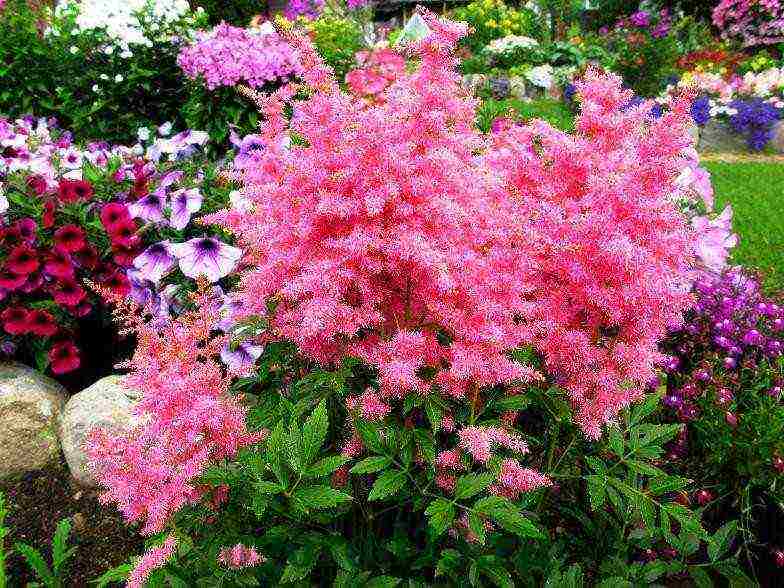
↑ to content ↑ Astilba - description, appearance and features
Astilba blooms most actively for about a month, starting from the first days of summer, the flowering process itself continues until August. Not only flowers are decorative, but also long-stemmed dark green leaves of astilba growing on erect stems. The color scheme of lush panicles is rich in a variety of shades: white, cream, pink, lilac, red. The delicate aroma of astilba is somewhat reminiscent of the scent of bird cherry.
The homeland of the flower is Japan and Asia, the number of varieties reaches 200 varieties, there are dwarf ("Lilliput"), tall varieties of astilbe (Arens hybrids). Compliance with simple agrotechnical rules, even for a novice gardener, allows you to grow a lush, eye-catching plant - which is why this culture is so loved by many. For ideal growth and development, astilbe needs a shadow, but not too strong. The so-called "lace" shadow from the crown of trees is what you need.
Photo of Astilba:
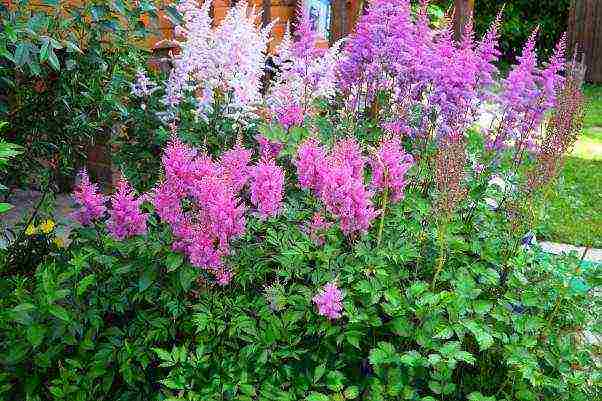 Astilba will make any corner of the garden cozy
Astilba will make any corner of the garden cozy
With the onset of cold weather, the aerial part of the astilba dies off, and the overwintered root gives new shoots with the onset of spring. A remarkable feature of astilba is that its rhizomes grow from above. Thus, buds are tied on the upper part of the root system, which are exposed, therefore, they require an annual top-up of soil. Each year, their size increases, forming new roots, while the lower part gradually dies off. Panicle flowers reach from 10 to 50 cm in length, when the flowering period ends, in their place are boxes with seeds inside.
For comfortable cultivation, it is preferable to give your choice to tall varieties - those that grow up to 50-80 cm. They are more resilient, tolerate climatic changes and temperature changes well.
As mentioned above, there are many different types of this plant, but most summer residents liked the Japanese astilba. This variety is also called Astilba Montgomery, a hybrid bred by German breeder Georg Arends in 1837.
Arends's hybrids are the brightest, most beautiful, unpretentious, they grow well on any soil, are resistant to cold, bloom for a long time (about 40 days). In addition to Montgomery, Gloria, Deutschland, Europe, Rheinland are popular among gardeners.
Japanese Astilba grows up to 80 cm high, has ornamental leaves, its flowers bloom early. After the flowers have faded, they do not lose their decorative qualities, do not spoil the overall picture of the garden with their appearance, and are often used to compose dry bouquets.
↑ back to contents ↑ Where to plant astilba
The most important requirement when planting an astilbe is to choose a comfortable place for it, preferably in the northern part of the site. The best time to start planting is early May / early June. Choose shady places or an area near the pool, reservoir (if you have one), keep in mind that only some varieties of astilba prefer sunny areas. As mentioned above, this plant can grow on almost any soil, but it especially loves loams, fertile soil, soil saturated with potassium-phosphorus additives.
If the soil is acidic, it is recommended to add some wood ash before planting to lower the pH level, and dolomite flour can also be used for this purpose.
When planting, be sure to take into account the proximity of plants, for example, hostas growing nearby will not only harmonize with the leaves or flowers of astilba, but will protect it from overheating in hot summer. You also need to pay attention to the variety, the timing of its flowering. Early, late varieties will feel equally comfortable in a sunny, shaded place. For varieties that bloom in the midst of summer, only shaded areas need to be selected.The high occurrence of groundwater, as well as periodic stagnation of water in the area, is extremely undesirable for astilba. To prevent the root system from getting wet, you will need to arrange drainage or plant plants on a hill.
Make sure that the planting material (astilba roots) does not have rotten or dead fragments. The roots should not be too wet or too dry.
Please see the video selection of Astilba's photos.
↑ back to content ↑ Astilba - care and landing
The place on the site should be prepared before planting: dig up, uproot the roots of shrubs, remove weeds, fertilize the ground with manure or add peat additionally (about 2 buckets per 1 square meter). The pits for astilba bushes should be about 30 cm deep. Deep into them, it is recommended to add a little ash (a handful), mineral dressing, and then generously add water. Start planting. Make sure that at least 5 cm of soil is poured over the roots of the plant, which should be carefully compacted and then covered with a layer of mulch (also 5 cm). Peat or humus is suitable for mulching.
Astilba - photo of flowers in a flower bed:
 The main decoration of this flower bed is astilba
The main decoration of this flower bed is astilba
Astilba can be propagated by seed or vegetative method, in the second case, fragments of rhizomes or buds are used. After the plant fades, seeds ripen in capsules, they are sown in early March, but before that they are "hardened" with cold. To do this, take a suitable container, pour a mixture of peat with sand (equal proportions), scatter seeds on top, lay a 2 cm layer of snow on top of them (you can use snow from the freezer).
The snow will melt naturally, burying the seeds inside the soil. After the snow has melted, cover the container with glass or plastic wrap and then refrigerate for 3 weeks. For these purposes, the lower compartment is perfect, where vegetables are usually stored. During this period, already hardened seedlings will germinate, which will eventually turn into strong plants that are not afraid of cold and frost.
After the sprouts appear, move the container to a lighted place where the air temperature is at least + 20 ° C. Watering the seedlings should be extremely careful, for this it is better to use a syringe to direct the stream of water to the root. After the appearance of the first 3 full-fledged leaves, small astilbe can be seated in individual pots. It should be borne in mind that varietal crops are not propagated by seeds - hybrids do not retain their individual characteristics.
Rhizome division is the easiest, most effective way of reproduction. To do this, a full-fledged plant should be dug out, removed from the soil along with the roots, with an earthen lump. Then gently shake off the ground, expose the root system, take a knife, divide the root into fragments, and each piece should have at least 4 buds. After that, you need to plant the roots at a distance of 25-30 cm from each other, water it daily (not too abundantly).
Astilba - growing and care, photo:
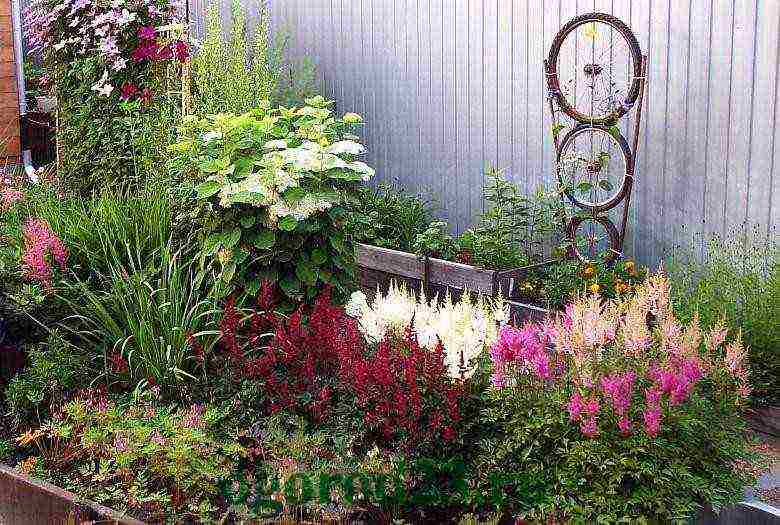 Different varieties of astilba are in perfect harmony with each other.
Different varieties of astilba are in perfect harmony with each other.
Reproduction by buds gives the fastest results. It is best to select seed in the spring, when new shoot growth is activated. The buds are carefully cut off together with a piece of rhizome, the place of the cut is sprinkled with ash or a pill of activated carbon crushed with a mortar. After that, take a container, fill it with a mixture of peat and gravel (for 3 parts of peat, 1 part of gravel), after which the buds are buried there, covered with glass or foil. When the plant germinates, gets stronger, it can be planted on the site using the method described above.
Astilba is aesthetic, undemanding, planting and care in the open field is not difficult, the main thing is to remember about the unusual feature of its root system, to ensure that the roots are covered with earth. Provide astilbe with regular watering (according to the variety). Mulching is desirable.Both overheating and waterlogging are equally harmful to all plants, and the mulch layer will help keep the roots healthy. Remove weeds, water more often during the formation of flowers, apply fertilizing according to the season: in the spring - nitrogen, in the middle of summer - potash, in the end of summer - phosphorus. Astilba should be transplanted every 8-10 years. With a competent approach to business, this plant will transform your summer cottage, give positive emotions, bright colors of summer.
↑ back to content ↑ Astilba, photo of flowers
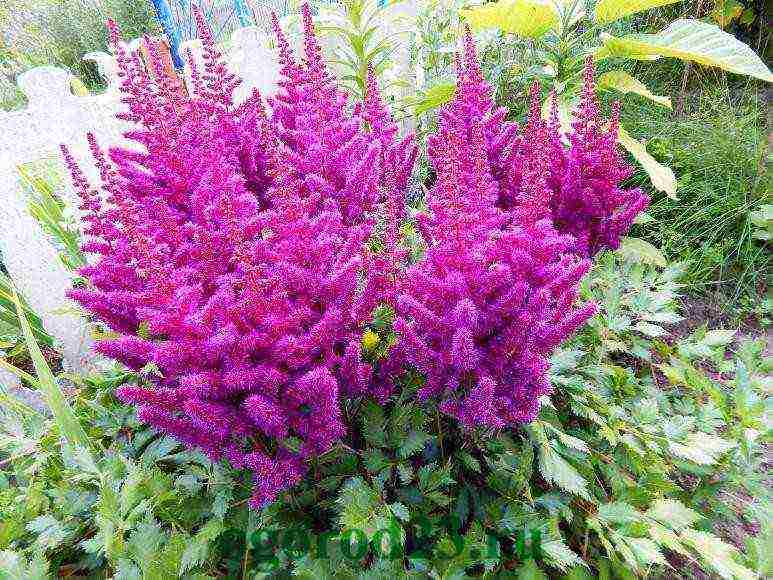
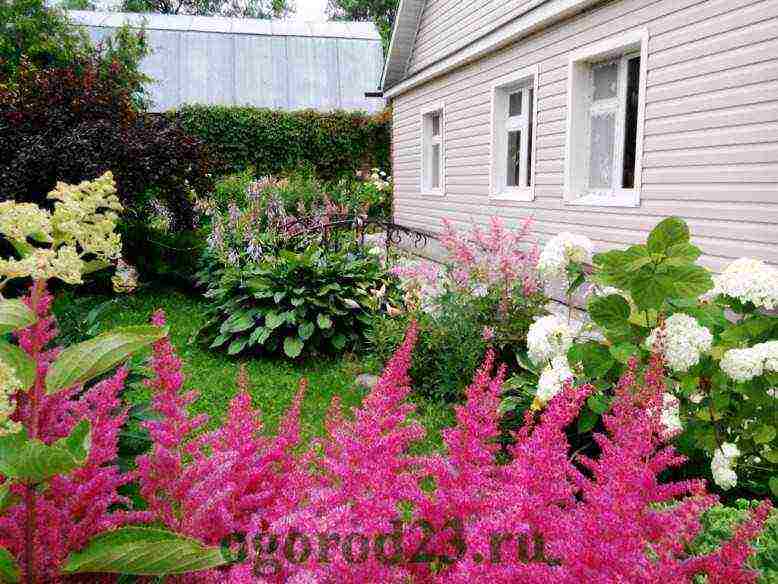
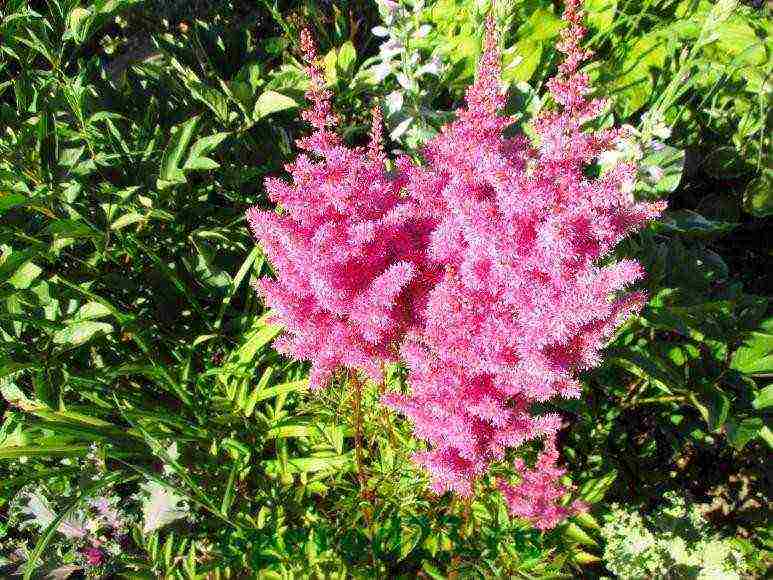
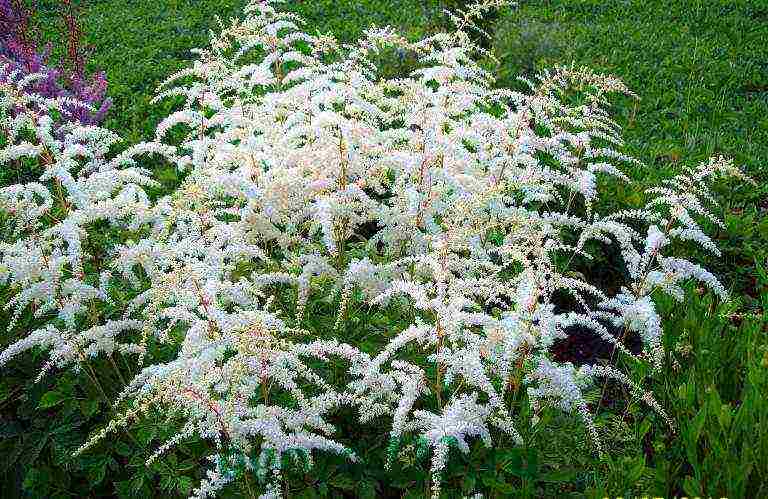
Botanical name: Astilbe.
Astilbe plant - family... Saxifrage.
Origin... Japan, China.
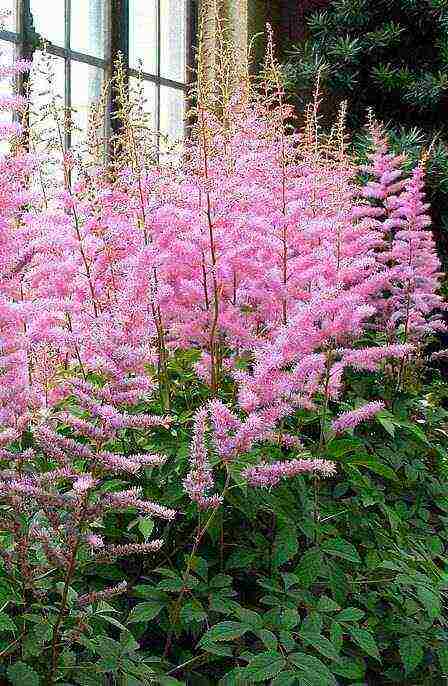
Astilba description. Perennial plant with beautiful, showy, fluffy, pyramidal inflorescences on top of thin but tough stems. The tiny flowers range in hue from white to pink and red. The plant remains in bloom for several weeks. Leaves are glossy, bright green, serrated. Inflorescences vary in size - from 15 cm to 60 cm, heights range from 15 inches to 150 cm, depending on the species.
Cultivars vary in size, shape, color, flowering time and leaf color. They grow quickly and even plants of the first year develop and bloom quickly.

Astilba varieties
Astilbe Arendsii
A. Arends is a large group of cultivated hybrids. Plants are perennials with complex, compound leaves. The leaves are dark green, oblong-lanceolate, leaf blades with small denticles along the edges. Inflorescences are apical, branched panicles of various shades - from white to burgundy. The onset and duration of flowering varies between varieties in this group.
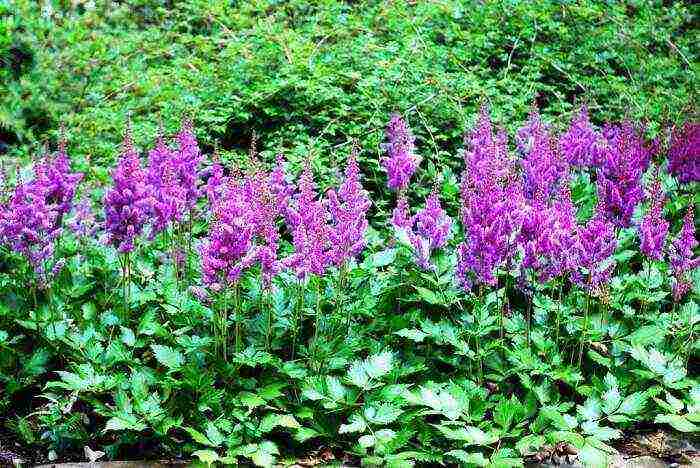
Chinese Astilba - Astilbe chinensis
Compact perennial plants with delicate green leaves. Inflorescences a. Chinese in shades of lilac or pink, they are more loose in shape, compared to other species, they are loose and strong. It grows slowly.
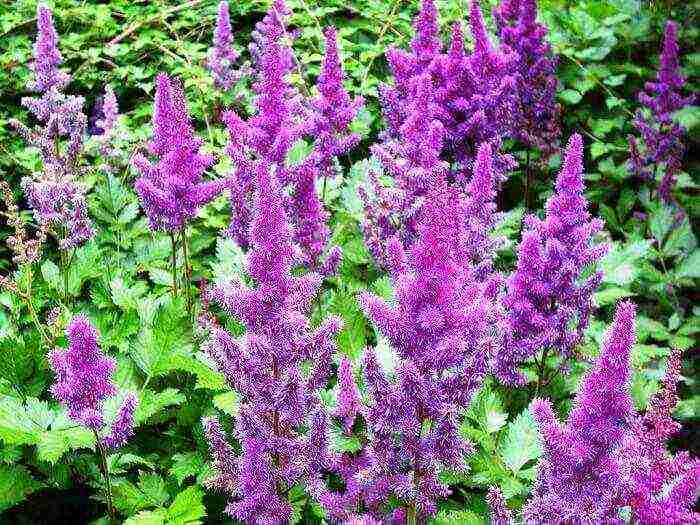
Japanese Astilbe - Astilbe japonica
A variety with graceful, lacy dark green, sometimes blue-green leaves. The inflorescences are very lush - mostly pink or dark - burgundy. Very well suited for cutting.
Height... 30 - 60 cm.
Astilba planting and care at home
Astilba in a pot - temperature... Prefers cool conditions, but the temperature should not drop below 10 ° C.

Lighting... Will bloom in the shade, but it is preferable to give her some sunlight. In hot weather, it is better to keep in partial shade.
How to grow astilba at home... Caring for astilbe is simple. Removing old flower stalks will improve the appearance of the plants, but you can leave them on the plant - they look equally impressive when dried. One of the easiest perennials to grow indoors, respond very well to proper maintenance. In the warm season, it is better to keep astilba outdoors.
Soil for astilba... Rich, moist soil, slightly acidic - pH about 6.0.
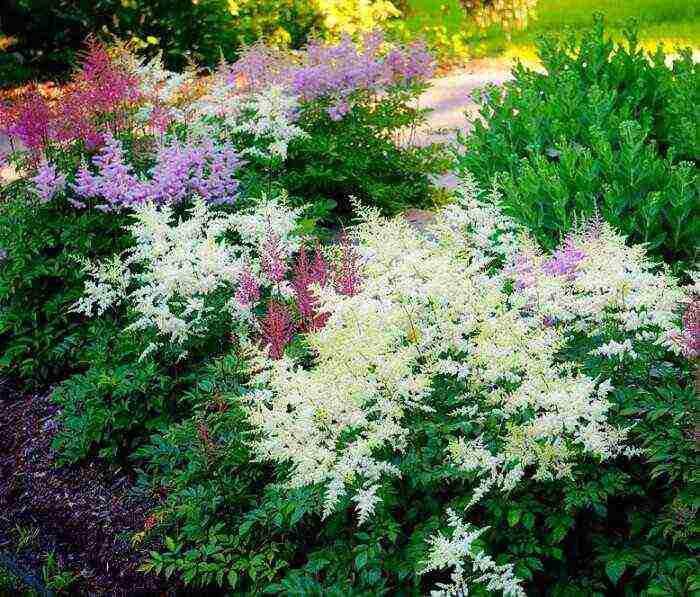
Growing conditions - feeding... A balanced organic fertilizer with a high phosphorus content, in the spring.
Appointment... Plants can be used for forcing.
Astilba bloom... A variety of shrub varieties will bloom from mid-spring to late summer. After flowering, the plant should be given a short rest period for several days - to reduce the temperature and frequency of watering.
Air humidity... Astilba flower should be periodically sprayed with plants to maintain the required moisture level.
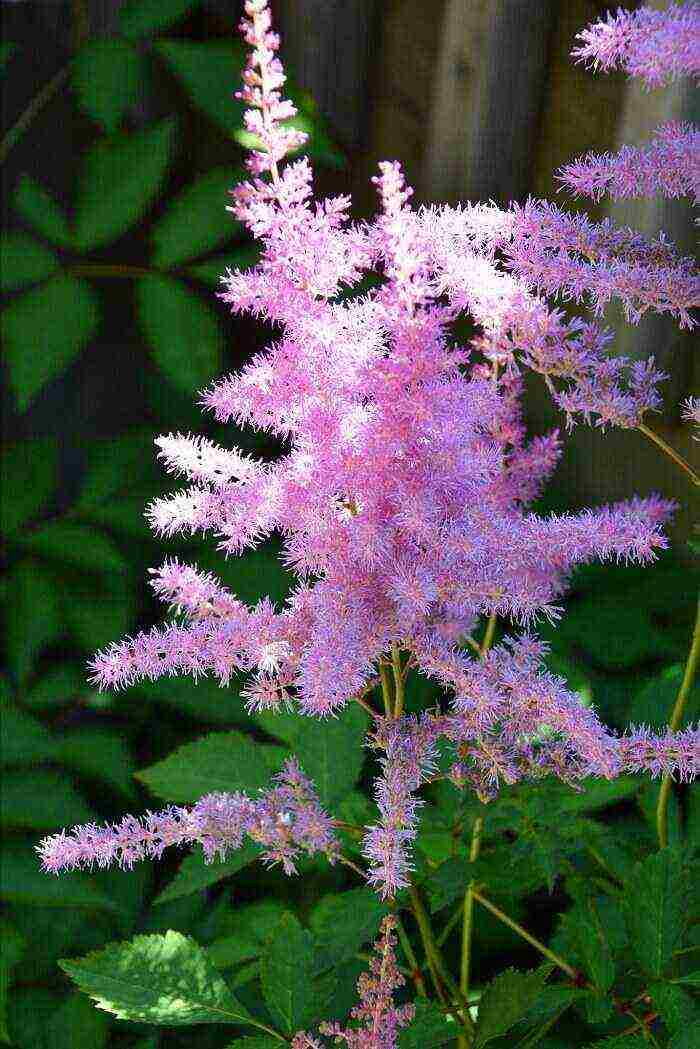
Soil moisture... The warmer the weather, the more moisture you need to give the plant, especially if you grow it in a sunny place.
Transplant - how to plant astilba... In spring, young plants - as the pot fills, annually.
Reproduction, astilba from seeds... It is possible to grow indoor plants from seeds, but they do not germinate well.Seeds are planted in spring or autumn, but not in summer - when it is hot, they are watered abundantly until sprouts appear. Mature plants are divided every 4-5 years or even more often. Delenki are also watered frequently and abundantly.
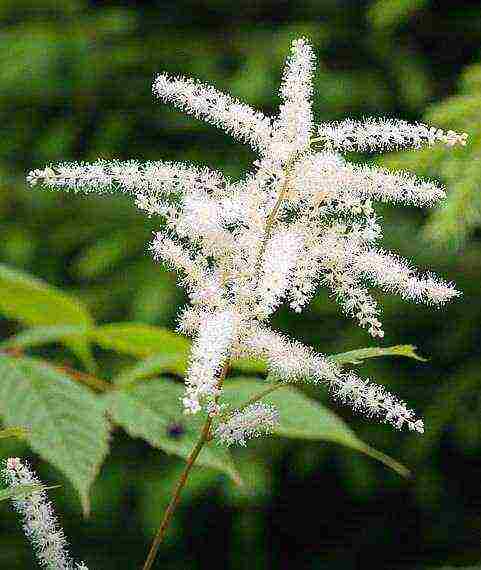
Astilba pests and diseases... When the soil dries, the leaves of these perennial flowers turn brown and dry out. Powdery mildew. Red spider mite.
Note... Faded plants are usually planted in open ground.
Hydroponics.
You may also be interested in:


